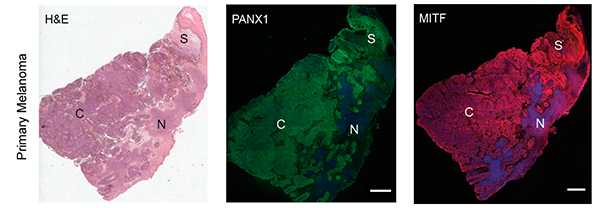Pannexin 1 in Cancer
Complementing our research on pannexins in healthy tissue homeostasis, the other area of focus in our research program is on their role in malignant transformation and cancer. Pannexins have been shown to be upregulated in many cancer types and to a play tumor promoting role in different tumours as reviewed in Jiang and Penuela, BMC Cell Biology, 2016. During Dr. Penuela’s PDF, she was the first to show a link between Panx1 and mouse melanoma tumorigenicity and metastasis (Penuela, JBC 2012). Our group has expanded that research focus into human melanomas, using established human melanoma cell lines, as well as patient tumours and patient-derived primary cells in a collaboration with our local surgical oncologists at the London Health Sciences Centre (LHSC). We discovered that Panx1 is highly expressed at all stages of melanoma progression in human patients in primary, nodal and distant metastatic tumors (Freeman et al., Cancers 2019). Using genetic tools and pharmacological blockers of Panx1 we observed that reducing or inhibiting channel function resulted in less tumor growth, migration, and invasion of melanoma cells in vivo, indicating Panx1 as a potential target for treatment. We have extended our experiments to other cancers such as glioblastoma where Panx1 appears to have a similar tumor promoting role. We use chicken embryo (chick-CAM) and in vivo mouse assays for screening existing and novel pannexin inhibitors that show promise as anti-cancer drugs to be used in combination treatments not only in melanoma, but also in other cancers where Panx1 acts as tumor promoter.









